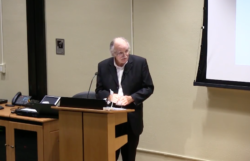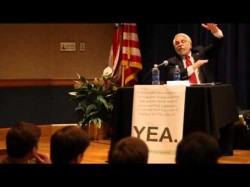Reflections on the Obama Presidency: (3) The Price of Moderation
(This is the third of four linked reflections. The first is available herei, and the second likewiseii)
When examining the gap between promise and performance in the Obama years, the bit that isn’t the Republican Party’s fault is the bit that is Obama’s. And there is one – certainly from a progressive point of view there is one: a progressive critique partly of the people he chose to work with, partly of the detail of the programs he chose to follow, and – biggest of all – partly of the programs that he did not.iii
All three of these weaknesses, from a progressive point of view, were recognized and articulated as the Obama years went on. Recognizing and articulating them was, indeed, the prime driving force behind the drafting and original publication of so many of the essays that are gathered in the volume related to this posting;iv and those essays never stood alone. They always stood alongside the writings of Robert Kuttner, Paul Krugman and others who argued from the outset of the Obama presidency that his theory of power was at fault: that being determinedly “bi-partisan, detached and staying above the fray”v would cost him (and us) a crucial FDR moment. This critique by leading progressives focused heavily during the first Obama term on the size of the initial stimulus package, and on the Administration’s caution in relation to failing banks, opting as the Administration did “for propping them up and disguising the big holes in their balance sheets rather than cleaning the banks out.” The result, in the view of his progressive critics at least, was that by conceding so much to his Republican opponents from Day 1, the President quickly lost both the policy initiative and the “broader philosophical war.”vi He also, in the process, helped lose the Democrats control of the House of Representatives in 2010; a loss that led Robert Kuttner to write at the time that linking the mid-term “shellacking” to the President’s penchant for bi-partisanship and policy caution was “not Monday morning quarterbacking.” On the contrary, “people on his own economics team, such as Christina Romer, were telling him that the stimulus was far too small, and that it was too tilted to tax cuts” and “several of America’s best economists – Joseph Stiglitz, Paul Krugman., Simon Johnson, Nouriel Roubini – were making these [same] criticisms at the time. So was the Congressional Oversight Panel ably led by Elizabeth Warren, which explains,” Kuttner thought late in 2010 “why Tim Geitner [kept] trying to do her in.”vii
From a progressive point of view, the problem here was not an excess of wisdom based on hindsight. The problem here was a tendency to policy caution in the pursuit of Republican support: which is why, to those on the right of the Democratic Party coalition who blamed the mid-term losses in 2010 on an over-focus on healthcare reform rather than on policy-timidity, Paul Krugman at least was caustic in response: “Mr. Obama’s problem wasn’t lack of focus,” he wrote, “it was lack of audacity. At the start of his administration, he settled for an economic plan that was far too weak. He compounded this original sin by pretending that everything was on track and by adopting the rhetoric of his enemies.”viii He failed, that is, to capitalize upon the key moment of ideological openness created by the visible discrediting of free-market economics and trickle-down tax cuts during the worst of the financial crisis late in 2008. To quote Robert Kuttner again;
Obama’s critics contend that his prolonged fantasy of bipartisanship, his failure to lay the blame for the depressed economy, and his reluctance to use his bully pulpit to tell a coherent story, particularly about jobs, needlessly weakened the Democrat and led to avoidable losses in the 2010 midterm. More fundamentally, under Obama government has lost credibility as a necessary force for economic recovery and fairness, undermining the Democrats’ core appeal to voters. At the very least, Obama failed to drive the agenda or exploit the full possibilities of presidential leadership in a crisis.”ix
This is not to deny that Obama’s choice of personnel was sometimes outstanding: Joe Biden as Vice-President must be the best example of that. But Rahm Emanuel as his first chief of staff, Larry Summers as his first director of the National Economic Council, Tim Geithner to be followed as Treasury Secretary by Jack Lew,x and the retention of Robert Gates as his first defense secretary – all those appointments spoke to an Obama failure to break fundamentally either with the neoliberal economic policies that produced the financial crash or the recession, or with the neo-conservatism that sent us initially into Iraq. In each area, there were progressive shifts, of course: including a stimulus package and help to homeowners that John McCain as president would doubtless not have implemented, and a determination to wind down the Iraq War that John McCain most certainly would not have demonstrated. But still, this was an Administration that began with a stimulus package that was too small, and too driven by tax cuts rather than infrastructure spending;xi and it was an Administration that ended having organized both a surge back into Afghanistan, and now the steady incremental increase in the number of US special forces on the ground across virtually the entirety of the Middle East. And as the President’s passion for the Trans-Pacific Partnership demonstrates only too well, the Obama Administration was one that broke with austerity politics but not with neoliberalism; just as the extensive use of drone warfare demonstrates that this was an Administration that broke with the Iraq War but not with the concept of America as a global military force. The Obama Administration broke with one war, but not with war itself.
There is no need to repeat the detail of this criticism here. What needs emphasizing instead is the broad limitation of a strategy of reaching across the aisle, and seeking bipartisan agreement, in the context of an aisle dominated on its right side by an ultra-conservative Republican Party. I realize well enough that bipartisanship is how the American system of government was intended to operate, and how indeed it did operate right through into the second Bush presidency. But bipartisanship only works if a liberal wing exists within the Republican Party to match the conservative wing within the Democratic Party. Given the absence of the former now, it is surely time for the Democrats to dump the latter – to move both parties, that is, towards more ideologically coherent sets of differences, and towards one-party rule (and effective governance, European style) whenever one party captures both Houses of Congress and the White House in the same election cycle. To talk in French terms, the Founding Fathers favored ‘cohabitation;’ but to cohabit successfully both of you need to like each other, and those days of mutual respect and tolerance are now gone. Barack Obama was reluctant to admit this. He tried to be a president for all Americans – an aspiration that is to some degree endemic to the job – but in truth the days of such presidencies (if they ever existed – think of the class hatred that fell on FDR in the 1930sxii) have now gone. Barack Obama as President kept reaching across the aisle, only to meet total rejection there. Charm offensives, as we observed earlier, are only needed when they are already pre-doomed to failure. If Democrats want to be part of the new politics – the politics of partisanship – they as a party will need to get their own coherence together, and to fight fire with fire.
This is an extract from the closing essay in David Coates, The Progressive Case Stalledxiii Published by Library Partners Press, and bringing together all the Coates’ postings on Barack Obama’s second term. The postings on the Obama first term are also available, collected together as Pursuing the Progressive Case.xiv Together, the two volumes make up Observing Obama in Real Time.
iii See, for example, Matt Stoller, “The progressive case against Obama,” posted on Salon.com October 27, 2012: available at http://www.salon.com/2012/10/27/the_progressive_case_against_obama/
Or
Robert Kuttner, “Obama and the prospects for American progressives,” Renewal, 20.2-3, September 19, 2012: available at https://www.lwbooks.co.uk/renewal/20-2-3/obama-and-prospects-american-progressives-interview-robert-kuttner
iv https://www.amazon.com/Progressive-Case-Stalled-Observing-Obama-ebook/dp/B01MYOWUSO/ref=sr_1_1?s=books&ie=UTF8&qid=1480953310&sr=1-1
v Robert Kuttner, “Barack Obama’s Theory of Power,” The American Prospect, June 2011, p. 12: available at http://prospect.org/article/barack-obamas-theory-power
vi Ali Berman, “Obama: Triangulation 2.0?” The Nation, February 7, 2011, p. 24: available at http://www.nationinstitute.org/tags/triangulation/
vii Robert Kuttner, What Lessons of Election Day? Huffington Post, October 31, 2010: available at http://www.huffingtonpost.com/daily-briefing/2010/11/robert-kuttner-what-lessons-of.html
viii Paul Krugman, “The Focus Hocus-Pocus,” The New York Times, November 4, 2010: available at http://www.nytimes.com/2010/11/05/opinion/05krugman.html
ix Robert Kuttner, “Barack Obama’s Theory of Power,” op.cit, p. 12.
x Robert Scheer, “The Inconvenient Truth About Jack Lew,” Huffington Post, January 11, 2013: available at http://www.truthdig.com/report/item/the_inconvenient_truth_about_jack_lew_20130111
xi Ezra Klein, “Obama’s Flunking Economy: The Real Cause,” The New York Review of Books, November 24, 2011: available at http://www.nybooks.com/articles/2011/11/24/obamas-flunking-economy-real-cause/
xii See H. W. Brands, Traitor to His Class: The Privileged Life and Radical Presidency of Franklin Delano Roosevelt. New York: Doubleday, 2008.
xiii Available at https://www.amazon.com/Progressive-Case-Stalled-Observing-Obama-ebook/dp/B01MYOWUSO/ref=sr_1_1?s=books&ie=UTF8&qid=1480953310&sr=1-1
xiv Available at https://www.amazon.com/Pursuing-Progressive-Case-Observing-Obama-ebook/dp/B01N77BP87/ref=sr_1_1?s=books&ie=UTF8&qid=1480953147&sr=1-1&keywords=Pursuing+the+progressive+case
Tags: Barack Obama, bipartisanship, Iraq War, stimulus package, war
David Coates holds the Worrell Chair in Anglo-American Studies at Wake Forest University. He is the author of Answering Back: Liberal Responses to Conservative Arguments, New York: Continuum Books, 2010.
He writes here in a personal capacity.





